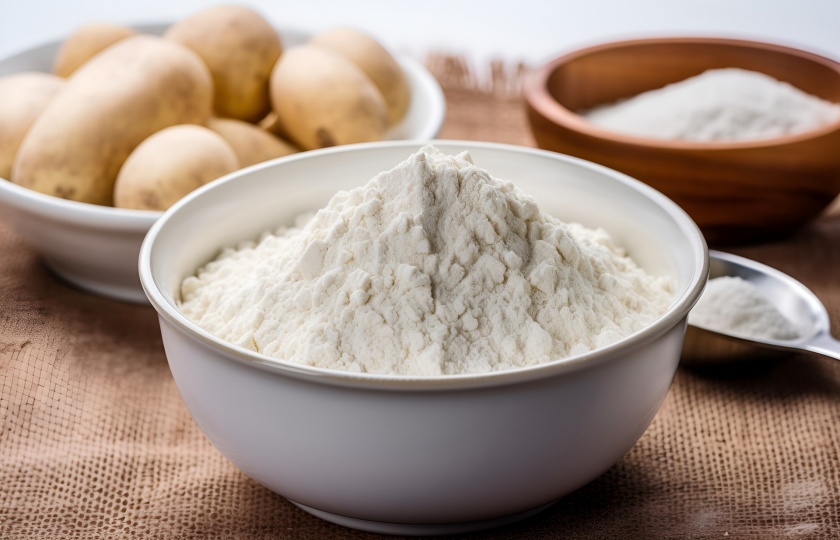Potato Starch Sub: Effective Substitution Options

Run out of potato starch when baking? Don't worry. Here are some alternatives to potato starch!
Potato Starch Sub
Corn Starch
Corn starch might be the most popular alternative to potato starch. It's readily available in most kitchens and has similar thickening properties. It's an excellent ingredient for baked goods, sauces, gravies, and soups.
Tapioca Starch
The second-best alternative to potato starch is tapioca starch, a fine white powder made from cassava roots. It's gluten-free and has a neutral taste. Tapioca starch is also known as tapioca flour. It's great for baked goods, fruit pies, and Asian desserts that require elasticity. Compared to cornstarch, tapioca starch thickens at a lower temperature, giving a chewy and smooth texture.
Arrowroot Powder or Arrowroot Starch
Arrowroot powder or arrowroot starch can also be used as a substitute for potato starch. Arrowroot powder is a fine, gluten-free starch extracted from plants of the Maranta genus. It's perfect for glazes, sauces, and pie fillings. Since arrowroot powder doesn't break down easily, it's suitable for foods that need to be frozen or reheated.
Rice Flour
Rice flour can also be used to replace potato starch. There are two types of rice flour, white and brown, which are good substitutes for thickeners.
It's especially suitable for gluten-free baking and coating foods before frying. Although rice flour may be a bit grainy, it's best to mix it with other flours for a smoother texture.
Wheat Flour or All-Purpose Flour
Wheat flour or all-purpose flour is a common ingredient in most kitchens. It can be used as a thickener instead of potato starch. It has a silkier texture and needs to be cooked longer to avoid a raw flour taste. Also, it contains gluten.
Coconut Flour
Coconut flour is another gluten- and grain-free alternative that can replace potato starch and has a unique flavor. Made from dried coconut meat, it also provides fiber, protein, and other nutrients.
Similar to potato starch, it can absorb water, making it an excellent flavor enhancer for soups and sauces.
Xanthan Gum
Xanthan gum is another great alternative to potato starch. You may not have this in your kitchen, but fortunately, it can serve as a great thickener.
Made from fermented sugar, xanthan gum is perfect for thickening soups, condiments, and sauces. It's also a popular choice for gluten-free baking as it can provide structure and elasticity to doughs and batters.
Guar Gum
Like xanthan gum, guar gum is a gluten-free thickener made from guar beans. It's ideal for cold foods such as puddings and ice creams.
Similar to xanthan gum, guar gum has a smooth texture, but it should be used with caution to prevent excessive thickness.
Psyllium Husk
Psyllium husk is a fiber-rich alternative that can mimic the binding properties of potato starch. It's often used in gluten-free and low-carbohydrate baking.
It's recommended to add psyllium husk in a 1:1 ratio, but remember that it absorbs a lot of liquid, so adjust the recipe accordingly.
Flaxseeds
Flaxseeds can be used as a substitute for potato starch in some applications, mainly as a binder rather than a thickener.
When ground flaxseeds are mixed with water, a gel-like substance is produced, which can mimic the binding properties of potato starch in recipes like vegan baking, where eggs are usually used as a binder.
This makes flaxseeds a suitable substitute in recipes for muffins, pancakes, and certain types of bread, where the aim is to bind the ingredients together.
What Does Potato Starch Do in Baking?
Increase Tenderness
Potato starch can reduce the gluten content in flour, making baked goods like cakes and cookies lighter and more tender in texture.

Enhance Moisture
Potato starch absorbs and locks in moisture, keeping baked goods moist and preventing them from drying out, especially suitable for gluten-free baking.
Boost Crispness
In baked goods like cookies and tart crusts, potato starch can increase crispness, making the texture lighter and less hard.
Improve Texture and Structure
When used in cake and bread recipes, it can enhance the overall fineness and softness, making the finished products fluffier and more even.
Can You Sub Potato Starch for Rice Flour?
Potato starch can replace rice flour (rice flour) in some cases, but not in all recipes.
Situations Where Replacement is Possible:
Thickening purposes (such as soups and sauces) - Potato starch and rice flour can be used as thickeners in a similar way.
Gluten-free baking (such as cakes and muffins) - Replacing a moderate amount of rice flour can increase softness and moisture.
Coating for fried foods (such as fried chicken and tempura) - Potato starch can provide a crispier outer layer.
Situations Where Replacement is Not Suitable:
As the main ingredient in bread and pastries - Rice flour has a certain ability to support the structure, while potato starch lacks gluten and using it alone will make the finished product too crumbly.
Rice-based foods (such as rice cakes and rice rolls) - These foods rely on the elasticity and texture of rice flour, and potato starch cannot fully replace it.
Are Flour and Potato Starch Interchangeable?
Flour and potato starch are not exactly the same. They can be substituted for each other in some cases, but not completely, depending on the use of the recipe.

Situations Where Replacement is Possible:
Thickening purposes (such as soups and sauces): Potato starch has a stronger thickening effect than flour. You can use half the amount of potato starch.
Coating for fried foods (such as fried chicken and tempura): Potato starch can provide a lighter and crispier texture.
Partially replacing in baking recipes (such as cakes and cookies): Adding an appropriate amount of potato starch can make the finished product softer and finer.
Situations Where They Cannot be Completely Interchanged:
Bread, noodles, and fermented pastries: Flour contains gluten (gluten), which can form a supporting structure, while potato starch does not contain gluten and cannot provide the same elasticity and chewiness.
Foods like dumpling wrappers and dough: Potato starch is too fine and cannot form a glutenous structure like flour. Using it alone will make the dough too fragile.
Does Cornstarch Do the Same as Potato Starch?
Corn starch and potato starch have similar functions in cooking, but there are significant differences between them and they cannot be completely interchanged.
Similarities:
Thickening Function
Both corn starch and potato starch are often used to thicken sauces, soups, or stews. They can make the liquid thicker and enhance the texture and luster of the dishes.
Gravy Effect
Both can be used to make gravy, making the surface of the dishes smoother.
Differences:
Transparency
Potato starch usually forms a more transparent texture after heating, making it suitable for dishes that require a transparent or semi-transparent effect. Corn starch has slightly lower transparency, and the thickened liquid may appear more cloudy.
Viscosity and Stability
The viscosity of corn starch is relatively stable and can maintain a good thickening effect even at high temperatures. Potato starch may lose some of its stickiness at high temperatures and is more suitable to be added later in the cooking process.
Texture
Potato starch has a finer texture and is suitable for dishes that require a smooth texture. Corn starch is more suitable for scenarios where increased viscosity and stability are needed.
Usage Recommendations:
For making transparent gravies or dishes that require a fine texture, choose potato starch first.
For maintaining a stable thickening effect at high temperatures or in baking and other scenarios that require a stable structure, choose corn starch first.
How Do You Make Potato Starch?
Ingredients
2 medium-sized potatoes
Equipment
Food processor or hand-held blender
Sieve or cheesecloth
Clear glass or bowl
Steps
Cut the potatoes into quarters and soak them in water for 20 minutes.
Use a food processor or hand-held blender. Put the potatoes into the water and blend until the liquid becomes cloudy and the potatoes turn into small pieces.
Separate the larger potato pieces from the liquid they were soaked in. Pour the mixture into a sieve or filter it through cheesecloth.
Let the liquid stand for about an hour until it settles. You will see a layer of white stuff at the bottom of the container - this is the starch we need. Pour off the liquid until only the starch remains.
Continue to soak the potato pieces in water and filter until the water runs clear instead of cloudy. This will ensure you get as much starch as possible.
Scrape the starch out of the container and spread it thinly on a non-stick surface to dry. If necessary, you can use a dehydrator or a low-temperature oven to speed up the process.
After drying, peel off the dried starch and put it into a food processor. Blend until it turns into a fine white powder.























